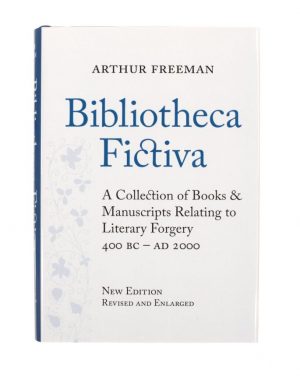Copies are available in our shop or online here
Bibliotheca Fictiva (2014), the record of a private collection of printed and manuscript Literary Forgery, c. 400 B.C- to A.D. 2000, was described and catalogued in 2014, with a total of 1676 entries (some of multiple items) and an accompanying ‘Overview’ of the material covered, from pre-Classical to (roughly) present day specimens, representing chiefly Western civilization in Europe, nearer Eurasia, and the Americas. Generously received, this necessarily selective work has served to some extent as a reader’s guide to the field (as defined by the collectors and their immediate forbears), in a period of rapidly increasing attention to its long-term history – both in academic circles and the popular press, through in study and research from introductory to advanced levels, with international projects and conferences now crowding the cross-cultural calendar as never before.
In this full revision of the 2014 text, Bibliotheca Fictiva has been essentially re-designed to represent what it has now become: a specifically institutionalized teaching, study, and research-oriented resource at the Sheridan Libraries of Johns Hopkins University, the catalogue of which – in addition to the ongoing digitization of the entire Collection, and other projects in progress–is intended to facilitate its use for such purposes, as well as providing an ongoing model for its continuation, maintenance, and enlargement. The original numbering of the main list of works comprised has been retained, so as not to obviate or confuse references to the 2014 Edition that may be already in use, and the numerous additions now made to that choice – reflecting not only the yield of a decade’s assiduous acquisitions by the Sheridan Library, but the incorporation of relevant titles already held at Johns Hopkins – are assigned decimalised numbers within the text (and of course in the essential index, here fully overhauled), now constituting a supplement of no fewer than 600 to the original 1676 of 2014.
Among the entirely new entries of forgeries by or of authors not in the collection of 2014 we might signal Euripides, Herodotus, Homer, Xenophon, and pseudo-Aristotle, Catullus, Tertulian, Lucius Florus, the Byzantine Patriarch Photius, and Aethicus Ister, pseudo-St. Paul, the illusory ‘Pope Joan’, Petrarch, Rabelais, Conrad Celtes and Ortensio Lando, the prototypography claimant Laurens Coster, Francesco Colonna, Constantine Lascaris, and Anne Boleyn, the ‘Lead Books of Sacramonte’, the fictive correspondence between Héloise and Abelard, and the pseudo-medieval ‘Traité des Trois Imposteurs’; subsequently John Donne, James Howell, the Earl of Rochester and Daniel Defoe (redeemed from former omission), the ‘unfortunate’ William Dodd, Henry Fielding, Jean-Jacques Rousseau, Thomas Paine, the ‘ophthalmiater’ John Taylor, and the bitter John Logan-Michael Bruce authorship controversy over the ‘Ode to a Cuckoo’, the untrustworthy eighteenth-century archeologists Michel Fourmont and Pasch van Krienen, the Italian Sappho forgers Imperiale and Verri, and some unexpected American newcomers. And among the significant additions to those already listed are pseudo-Phalaris, the Sibylline Oracles, Abgar of Edessa (and his correspondent, Jesus Christ), Eusebius of Caesarea, Annius of Viterbo, Mary Queen of Scots, Paul Merula (thirty-six new entries), the fictional ‘Portuguese Nun’ Maria Alcoforado, Samuel Johnson, Swift, Rochester, ‘Ossian’ Macpherson, ‘Munchhausen’ Raspe, William Henry Ireland, Lord Byron, John Payne Collier, the Walter Scott forgers Häring and Cabany, Renier ‘Count Fortsas’ Chalon, Guglielmo Libri, Václav Hanka, the deadly Protocols of the Elders of Zion, and important new Constantine Simonides material. And while we continue to limit our inclusions in Bibliotheca Fictiva to essentially textual materials, in the present revision we have admitted a sampling of a few closely associated illustrative and physical objects, i.e., chiefly modern forged ‘period’ bindings by Théodore Hagué, Icilio Federico Joni’s ‘tavolette covers’, and the ‘Apollo and Pegusus’ specialist Vittorio Villa, as well as pictorial fabrications by the ubiquitous and still mysterious ‘Spanish Forger’ and some skilled but deceptive contemporaries whose works have formerly passed muster as genuinely antique.
Furthermore, the old secondary descriptions – which formerly might require re-consultation of the ‘Overview’ to explain their inclusion – have now frequently been clarified at some length, and the ‘Overview’ itself, corrected when necessary, is enlarged, specifically identifying material new to the revision.
Reviews of Bibliotheca Fictiva (2014)
‘The catalogue is worth reading in full for its lucid and scholarly descriptions of the individual copies, as well as of the books and their histories. There is a lifetime’s – or two lifetimes’, since Freeman fully acknowledges his wife’s contribution – knowledge and critical sense in this elegantly produced and well-illustrated book … Bibliotheca Fictiva provides an essential and splendidly detailed atlas of the subject’ (Henry Woudhuysen, in The Times Literary Supplement)
‘An immense and fascinating compendium of literary frauds and spuriosities covering more than two millennia, Bibliotheca Fictiva … speaks not only to a love of bookish hoaxes and mysteries, but also to the wide-ranging narratives of deceit and exposure that surround them … Far from denouncing literary forgery as criminal, Bibliotheca Fictiva endeavours to understand literary forgery as a genre unto itself … an ambitious achievement in bibliographical compilation, [it] affords textual scholars and book historians an invaluable resource into “this complicate, venerable, and culturally significant field of literary activity”’ (Gregory Mackie, in SHARP News)
‘Rarely can a book fifty years in the making arrive seeming so fresh-minted and topical. Bibliotheca Fictiva is a catalogue raisonné, [with] each item briefly described, and a magisterial 82-page introductory essay … offer[ing] an overview of the main themes, so that the book is both a handlist to the collection … and an object of instruction and delight in itself … a pleasurable and a salutary book, the underlying principal [of which] is that, given sufficient resources and will, forged material can be collected, studied, and exposed’ (Matthew Steggle, in Notes and Queries)
Copies are available in our shop or online here
